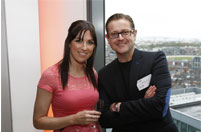There’s no going back |
| Michael Cullen reports from a seminar on the future direction of magazines |
Magazines Ireland could have emailed members with the message ‘be afraid, be very afraid’. The level of apprehension at Publishing 360 was palpable. Envoys from many of Ireland’s top consumer magazines sat attentive as Frank Quinn from Mediateam introduced the first speaker whose line was ‘the future is mobile, social and engaging’.
Colin Crawford is billed as a “digital media expert”. A former publisher of MacWorld in the US, he now runs the New Media 7 consultancy in San Francisco. If the assembled delegates expected the day’s headline speaker was going to wave a magic wand and provide the panacea for all publishers’ ills, they were soon reintroduced to reality.
There are no easy answers, Crawford warned. Move too fast is tricky and so is moving too slow, so “let’s not do anything”, which only accelerates the decline. Like a doctor dispensing the bad news about a terminally-ill patient to a loved one, he was not prepared to dilly-dally: “There’s a reluctance to abort the print model but the reality is, it’s over.”
So what now? And how do magazine publishers avoid going down a lot of cul-de-sacs? Crawford said the revenue stream from digital must be wide-ranging. The tablet has the biggest potential. We’re in the Zuckerberg rather than the Guttenberg era, with Facebook boasting 850 million users. Mobile will be the most “disruptive” as mobile numbers are the new “mining jewel”. “It’s not going to change, it’s going to get worse,” he added.
Crawford is a big Steve Jobs fan and lauds all the Apple empire has done to transmogrify the world. “There’s no real competitor to the iPad,” he said. “Revenues will flow. By 2015 there will be over 400 million tablet sales, with laptops in decline. Smartphones will be in the billions. Penetration in the US is already 50 per cent. Apps are the way to go.” Publishers have to find out for themselves the commercial opportunities from mobile.
The smartphone is becoming a wallet. When designing content, think of how it will translate to digital devices. Online is ‘lean into’, print ‘lean back’ and mobile is highly personal, combining both former elements. Publishers must ensure magazines are quickly downloadable and try and make them ‘an experience’ rather than ‘a use’.
Crawford says major magazine publishers like Dennis, Hearst and Conde Nast are reporting strong digital growth. Back issues account for 40 per cent of sales, along with other ways of pushing out archieval content. Publishers must be prepared to “suck up” the 30 per cent Apple demands as they pay it out anyway on traditional distribution.
The scale of digital audiences is “massive”. It can be hard to define return on investment (ROI) but carpe diem. In terms of social media, Crawford has his own way of explaining the choices in Ireland. For Twitter, tweet “I’m drinking Guinness”; on Facebook it’s “I like Guinness” and the message on LinkedIn is “I’m good at drinking Guinness”.
Publishers should claim their brands on Twitter and other social media and then decide on a strategy. By all means experiment, but be cautious. The most followed American magazines on Twitter include People, Time, InStyle, The Economist and Newsweek. How do you extend the life of a tweet? Twylah turns tweets into a custom brand web page.
Print is facing a huge cultural shift. Publishers need to get employees to think about digital and plan for it. Hearst is aggressively developing ecommerce ideas. There needs to be a focus on quality differentiators and getting customer information. Allow trial and error, mistakes will be made. Be selective about what you give away for free.
Hire interns to develop publishing concepts. As to what media owners can do to bridge the gap between print and online, he said he was unsure as to what exact path to take as the dynamics of the web are so different to hard copy. The data feed from digital is much richer, with every touch measured so it leads to more targeted advertising.
Crawford didn’t give a lot away. He admitted as much when he first took to the podium and told delegates his expertise was available for hire. But he was prepared to share some useful thoughts. It was apt Publishing 360 was held in Chartered Accountants’ House. The number crunchers may help publishers who get it right to count their lucky stars.
 |
WARNING SIGNSClients are moving spend into online and spending less, so it is all about survival, Radical’s Justin Cullen, pictured with Cera Ward, Google, said. Speaking at the Publishing 360 seminar on the future of magazines, Cullen said traditional advertising has been turned upside down. Adland will become a “bit part player”. Publishers must look outside Ireland and ignore the idea of pay walls. Fifteen years ago, 90 per cent of spend went through Irish media owners; nowadays half goes to overseas media owners. There are three large printing presses in Ireland – “that’s unreal”. Online spend expected to be around €152m this year. |









